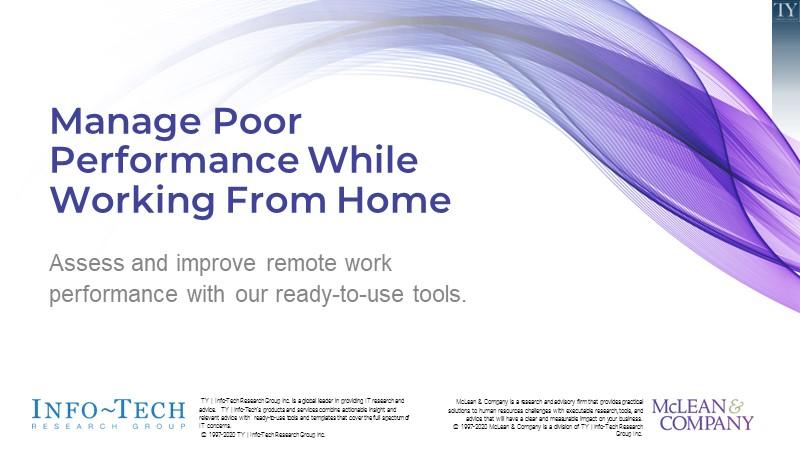
Manage Poor Performance While Working From Home
- For many, emergency WFH comes with several new challenges such as additional childcare responsibilities, sudden changes in role expectations, and negative impacts on wellbeing. These new challenges, coupled with previously existing ones, can result in poor performance. Owing to the lack of physical presence and cues, managers may struggle to identify that an employee’s performance is suffering. Even after identifying poor performance, it can be difficult to address remotely when such conversations would ideally be held in person.
Our Advice
Critical Insight
- Poor performance must be managed, despite the pandemic. Evaluating root causes of performance issues is more important than ever now that personal factors such as lack of childcare and eldercare for those working from home are complicating the issue.
Impact and Result
- Organizations need to have a clear process for improving performance for employees working remotely during the COVID-19 pandemic. Provide managers with resources to help them identify performance issues and uncover their root causes as part of addressing overall performance. This will allow managers to connect employees with the required support while working with them to improve performance.
Manage Poor Performance While Working From Home Research & Tools
Besides the small introduction, subscribers and consulting clients within this management domain have access to:
1. Follow the remote performance improvement process
Determine how managers can identify poor performance remotely and help them navigate the performance improvement process while working from home.
- Manage Poor Performance While Working From Home Storyboard
- Manage Poor Performance While Working From Home: Manager Guide
- Manage Poor Performance While Working From Home: Infographic
2. Clarify roles and leverage resources
Clarify roles and responsibilities in the performance improvement process and tailor relevant resources.
- Wellness and Working From Home
Further reading
Manage Poor Performance While Working From Home
Assess and improve remote work performance with our ready-to-use tools.
Executive Summary
McLean & Company Insight
Poor performance must be managed, despite the pandemic. Evaluating root causes of performance issues is more important than ever now that personal factors such as lack of childcare and eldercare for those working from home are complicating the issue.
Situation
COVID-19 has led to a sudden shift to working from home (WFH), resulting in a 72% decline in in-office work (Ranosa, 2020). While these uncertain times have disrupted traditional work routines, employee performance remains critical, as it plays a role in determining how organizations recover. Managers must not turn a blind eye to performance issues but rather must act quickly to support employees who may be struggling.
Complication
For many, emergency WFH comes with several new challenges such as additional childcare responsibilities, sudden changes in role expectations, and negative impacts on wellbeing. These new challenges, coupled with previously existing ones, can result in poor performance. Owing to the lack of physical presence and cues, managers may struggle to identify that an employee’s performance is suffering. Even after identifying poor performance, it can be difficult to address remotely when such conversations would ideally be held in person.
Solution
Organizations need to have a clear process for improving performance for employees working remotely during the COVID-19 pandemic. Provide managers with resources to help them identify performance issues and uncover their root causes as part of addressing overall performance. This will allow managers to connect employees with the required support while working with them to improve performance.
Manage Poor Performance While Working From Home is made up of the following resources:
1Identify2Initiate3Deploy4a) Follow Upb) Decide |
Storyboard
This storyboard is organized by the four steps of the performance improvement process: identify, initiate, deploy, and follow up/decide. These will appear on the left-hand side of the slides as a roadmap. The focus is on how HR can design the process for managing poor performance remotely and support managers through it while emergency WFH measures are in place. Key responsibilities, email templates, and relevant resources are included at the end. Adapt the process as necessary for your organization. |
Manager Guide
The manager guide contains detailed advice for managers on navigating the process and focuses on the content of remote performance discussions. It consists of the following sections:
|
Manager Infographic
The manager infographic illustrates the high-level steps of the performance improvement process for managers in a visually appealing and easily digestible manner. This can be used to easily outline the process, providing managers with a resource to quickly reference as they navigate the process with their direct reports. |
In this blueprint, “WFH” and “remote working” are used interchangeably.
This blueprint will not cover the performance management framework; it is solely focused on managing performance issues.
For information on adjusting the regular performance management process during the pandemic, see Performance Management for Emergency Work-From-Home.
Identify how low performance is normally addressed
A process for performance improvement is not akin to outlining the steps of a performance improvement plan (PIP). The PIP is a development tool used within a larger process for performance improvement. Guidance on how to structure and use a PIP will be provided later in this blueprint.
Evaluate how low performance is usually brought to the attention of HR in a non-remote situation:
|
Poor performance does not signal the immediate need to terminate an employee. Instead, managers should focus on helping the struggling employee to develop so that they may succeed. |
Evaluate how poor performance is determined:
|
Keep in mind that “poor performance” now might look different than it did before the pandemic. Employees must be aware of the current expectations placed on them before they can be labeled as underperforming – and the performance expectations must be assessed to ensure they are realistic. |
For information on adjusting performance expectations during the pandemic, see Performance Management for Emergency Work-From-Home.
The process for non-union and union employees will likely differ. Make sure your process for unionized employees aligns with collective agreements.
Determine how managers can identify poor performance of staff working remotely
1Identify2Initiate3Deploy4a) Follow Upb) Decide | Identify: Determine how managers can identify poor performance. |
| In person, it can be easy to see when an employee is struggling by glancing over at their desk and observing body language. In a remote situation, this can be more difficult, as it is easy to put on a brave face for the half-hour to one-hour check-in. Advise managers on how important frequent one-one-ones and open communication are in helping identify issues when they arise rather than when it’s too late. Managers must clearly document and communicate instances where employees aren’t meeting role expectations or are showing other key signs that they are not performing at the level expected of them. | What to look for:
|
It’s crucial to acknowledge an employee might have an “off week” or need time to adjust to working from home, which can be addressed with performance management techniques. Managers should move into the process for performance improvement when:
|
While it’s important for managers to keep an eye out for decreased performance, discourage them from over-monitoring employees, as this can lead to a damaging environment of distrust.
Support managers in initiating performance conversations and uncovering root causes
1Identify2Initiate3Deploy4a) Follow Upb) Decide | Initiate: Require that managers have several conversations about low performance with the employee. | ||||
| Before using more formal measures, ensure managers take responsibility for connecting with the employee to have an initial performance conversation where they will make the performance issue known and try to diagnose the root cause of the issue. Coach managers to recognize behaviors associated with the following performance inhibitors: | |||||
| Personal Factors Personal factors, usually outside the workplace, can affect an employee’s performance. | Lack of clarity Employees must be clear on performance expectations before they can be labeled as a poor performer. | Low motivation Lack of motivation to complete work can impact the quality of output and/or amount of work an employee is completing. | Inability Resourcing, technology, organizational change, or lack of skills to do the job can all result in the inability of an employee to perform at their best. | Poor people skills Problematic people skills, externally with clients or internally with colleagues, can affect an employee’s performance or the team’s engagement. | |
| Personal factors are a common performance inhibitor due to emergency WFH measures. The decreased divide between work and home life and the additional stresses of the pandemic can bring up new cases of poor performance or exacerbate existing ones. Remind managers that all potential root causes should still be investigated rather than assuming personal factors are the problem and emphasize that there can be more than one cause. | |||||
Ensure managers continue to conduct frequent performance conversations
Once an informal conversation has been initiated, the manager should schedule frequent one-on-one performance conversations (above and beyond performance management check-ins).
1Identify2Initiate3Deploy4a) Follow Upb) Decide | Explain to managers the purpose of these discussions is to:
| Given these conversations will be remote, require managers to:
|
| What is HR’s role? HR should ensure that the manager has had multiple conversations with the employee before moving to the next step. Furthermore, HR is responsible for ensuring manages are equipped to have the conversations through coaching, role-playing, etc. For more information on the content of these conversations or for material to leverage for training purposes, see Manage Poor Performance While Working From Home: Manager Guide. McLean & Company InsightManagers are there to be coaches, not therapists. Uncovering the root cause of poor performance will allow managers to pinpoint supports needed, either within their expertise (e.g. coaching, training, providing flexible hours) or by directing the employee to proper external resources such as an EAP. | ||
Help managers use formal performance improvement tools with remote workers
1Identify2Initiate3Deploy4a) Follow Upb) Decide | Deploy: Use performance improvement tools. | |
If initial performance conversations were unsuccessful and performance does not improve, refer managers to performance improvement tools:
| ||
| Using a PIP solely to avoid legal trouble and terminate employees isn’t true to its intended purpose. This is what progressive discipline is for. | In the case of significant behavior problems, like breaking company rules or safety violations, the manager will likely need to move to progressive discipline. HR should advise managers on the appropriate process. When does the issue warrant progressive discipline? If the action needs to stop immediately, (e.g. threatening or inappropriate behavior) and/or as outlined in the collective agreement. | |
Clarify remote PIP stages and best practices
1Identify2Initiate3Deploy4a) Follow Upb) Decide | Sample Stages:1. Written PIP
2. Possible Extension3. Final Notice
| Who is involved?The manager runs the meeting with the employee. HR should act as a support by:
Determine the length of the PIP
Timing of deliveryHelp the manager determine when the PIP meeting will occur (what day, time of day). Take into account the schedule of the employee they will be meeting with (e.g. avoid scheduling right before an important client call). |
1Identify2Initiate3Deploy4a) Follow Upb) Decide | Follow up: If the process escalated to step 3 and is successful.What does success look like? Performance improvement must be sustained after the PIP is completed. It’s not enough to simply meet performance improvement goals and expectations; the employee must continue to perform. Have the manager schedule a final PIP review with the employee. Use video, as this enables the employee and manager to read body language and minimize miscommunication/misinterpretation.
The manager should also continue check-ins with the employee to ensure sustainment and as part of continued performance management.
ORDecide: Determine action steps if the process is unsuccessful.If at the end of step 3 performance has not sufficiently improved, the organization (HR and the manager) should either determine if the employee could/should be temporarily redeployed while the emergency WFH is still in place, if a permanent transfer to a role that is a better fit is an option, or if the employee should be let go. See the Complete Manual for COVID-19 Layoffs blueprint for information on layoffs in remote environments. |
Managers, HR, and employees all have a role to play in performance improvement
Managers
- Identify the outcomes the organization is looking for and clearly outline and communicate the expectations for the employee’s performance.
- Diagnose root cause(s) of the performance issue.
- Support employee through frequent conversations and feedback.
- Coach for improved performance.
- Visibly recognize and broadcast employee achievements.
Employees
- Have open and honest conversations with their manager, acknowledge their accountability, and be receptive to feedback.
- Set performance goals to meet expectations of the role.
- Prepare for frequent check-ins regarding improvement.
- Seek support from HR as required.
HR
- Provide managers with a process, training, and support to improve employee performance.
- Coach managers to ensure employees have been made aware of their role expectations and current performance and given specific recommendations on how to improve.
- Reinforce the process for improving employee performance to ensure that adequate coaching conversations have taken place before the formal PIP.
- Coach employees on how to approach their manager to discuss challenges in meeting expectations.
HR should conduct checkpoints with both managers and employees in cases where a formal PIP was initiated to ensure the process for performance improvement is being followed and to support both parties in improving performance.
Email templates
Use the templates found on the next slides to draft communications to employees who are underperforming while working from home.
Customize all templates with relevant information and use them as a guide to further tailor your communication to a specific employee.
Customization Recommendations
Review all slides and adjust the language or content as needed to suit the needs of the employee, the complexity of their role, and the performance issue.
- The pencil icon to the left denotes slides requiring customization of the text. Customize text in grey font and be sure to convert all font to black when you are done.
Included Templates
- Performance Discussion Follow-Up
- PIP Cover Letter
This template is not a substitute for legal advice. Ensure you consult with your legal counsel, labor relations representative, and union representative to align with collective agreements and relevant legislation.
Sample Performance Discussion Follow-Up
Hello [name],
Thank you for the commitment and eagerness in our meeting yesterday.
I wanted to recap the conversation and expectations for the month of [insert month].
As discussed, you have been advised about your recent [behavior, performance, attendance, policy, etc.] where you have demonstrated [state specific issue with detail of behavior/performance of concern]. As per our conversation, we’ll be working on improvement in this area in order to meet expectations set out for our employees.
It is expected that employees [state expectations]. Please do not hesitate to reach out to me if there is further clarification needed or you if you have any questions or concerns. The management team and I are committed to helping you achieve these goals.
We will do a formal check-in on your progress every [insert day] from [insert time] to review your progress. I will also be available for daily check-ins to support you on the right track. Additionally, you can book me in for desk-side coaching outside of my regular desk-side check-ins. If there is anything else I can do to help support you in hitting these goals, please let me know. Other resources we discussed that may be helpful in meeting these objectives are [summarize available support and resources]. By working together through this process, I have no doubt that you can be successful. I am here to provide support and assist you through this.
If you’re unable to show improvements set out in our discussion by [date], we will proceed to a formal performance measure that will include a performance improvement plan. Please let me know if you have any questions or concerns; I am here to help.
Please acknowledge this email and let me know if you have any questions.
Thank you,
PIP Cover Letter
Hello [name] ,
This is to confirm our meeting on [date] in which we discussed your performance to date and areas that need improvement. Please find the attached performance improvement plan, which contains a detailed action plan that we have agreed upon to help you meet role expectations over the next [XX days]. The aim of this plan is to provide you with a detailed outline of our performance expectations and provide you the opportunity to improve your performance, with our support.
We will check in every [XX days] to review your progress. At the end of the [XX]-day period, we will review your performance against the role expectations set out in this performance improvement plan. If you don’t meet the performance requirements in the time allotted, further action and consequences will follow.
Should you have any questions about the performance improvement plan or the process outlined in this document, please do not hesitate to discuss them with me.
[Employee name], it is my personal objective to help you be a fully productive member of our team. By working together through this performance improvement plan, I have no doubt that you can be successful. I am here to provide support and assist you through the process. At this time, I would also like to remind you about the [additional resources available at your organization, for example, employee assistance program or HR].
Please acknowledge this email and let me know if you have any questions.
Thank you,
Prepare and customize manager guide and resources
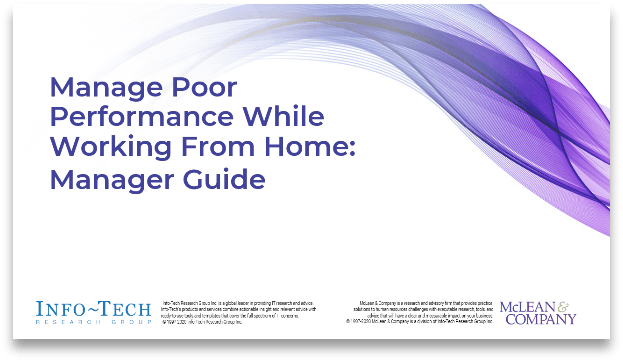 |
Manage Poor Performance While Working From Home: Manager Guide
This tool for managers provides advice on navigating the process and focuses on the content of remote performance discussions. |
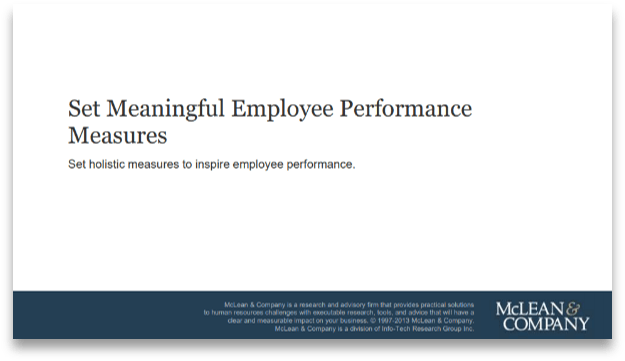 |
Set Meaningful Employee Performance Measures
See this blueprint for information on setting holistic measures to inspire employee performance. |
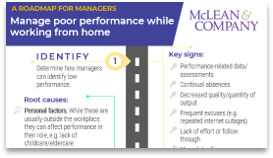 |
Manage Poor Performance While Working From Home: Infographic
This tool illustrates the high-level steps of the performance improvement process. |
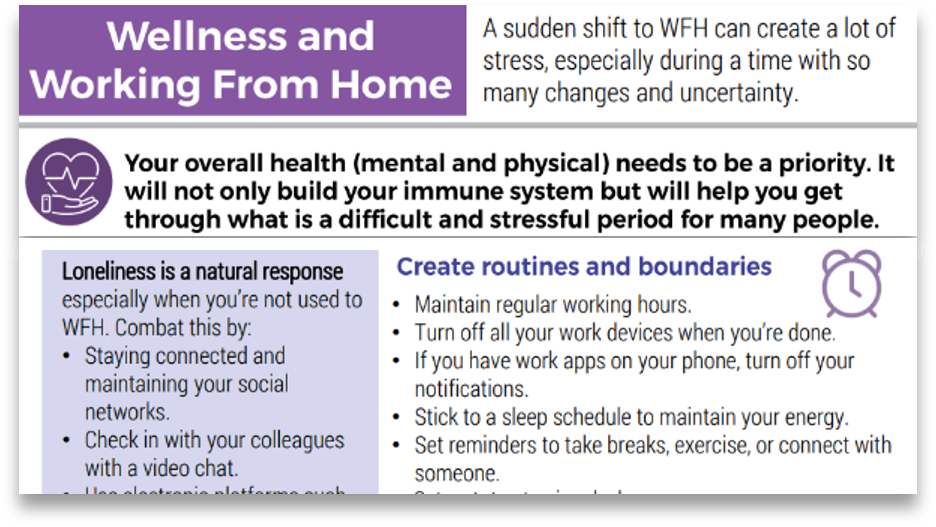 |
Wellness and Working From Home: Infographic
This tool highlights tips to manage physical and mental health while working from home. |
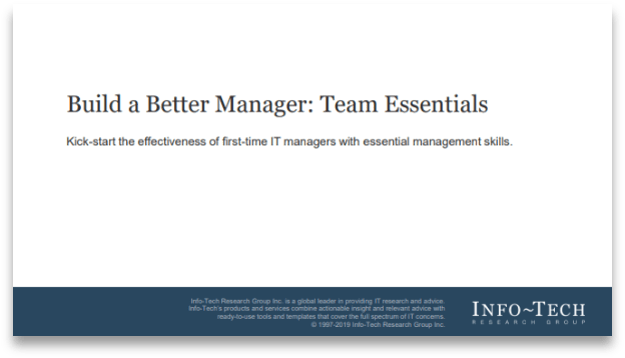 |
Build a Better Manager: Team Essentials
See this solution set for more information on kick-starting the effectiveness of first-time IT managers with essential management skills. |
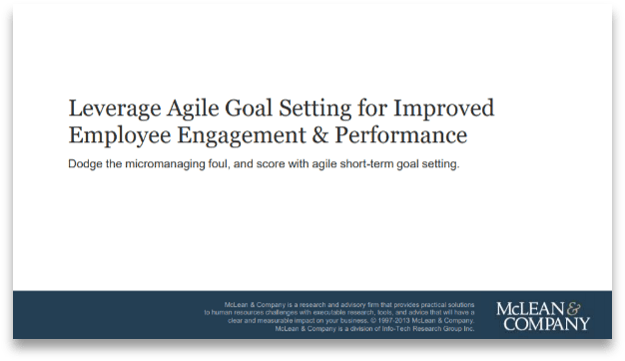 |
Leverage Agile Goal Setting for Improved Employee Engagement & Performance
See this blueprint for information on dodging the micromanaging foul and scoring with agile short-term goal setting. |
Bibliography
Arringdale, Chris. “6 Tips For Managers Trying to Overcome Performance Appraisal Anxiety.” TLNT. 18 September 2015. Accessed 2018.
Borysenko, Karlyn. “What Was Management Thinking? The High Cost of Employee Turnover.” Talent Management and HR. 22 April 2015. Accessed 2018.
Cook, Ian. “Curbing Employee Turnover Contagion in the Workplace.” Visier. 20 February 2018. Accessed 2018.
Cornerstone OnDemand. Toxic Employees in the Workplace. Santa Monica, California: Cornerstone OnDemand, 2015. Web.
Dewar, Carolyn and Reed Doucette. “6 elements to create a high-performing culture.” McKinsey & Company. 9 April 2018. Accessed 2018.
Eagle Hill. Eagle Hill National Attrition Survey. Washington, D.C.: Eagle Hill, 2015. Web.
ERC. “Performance Improvement Plan Checklist.” ERC. 21 June 2017. Accessed 2018.
Foster, James. “The Impact of Managers on Workplace Engagement and Productivity.” Interact. 16 March 2017. Accessed 2018.
Godwins Solicitors LLP. “Employment Tribunal Statistics for 2015/2016.” Godwins Solicitors LLP. 8 February 2017. Accessed 2018.
Mankins, Michael. “How to Manage a Team of All-Stars.” Harvard Business Review. 6 June 2017. Accessed 2018.
Maxfield, David, et al. The Value of Stress-Free Productivity. Provo, Utah: VitalSmarts, 2017. Web.
Murphy, Mark. “Skip Your Low Performers When Starting Performance Appraisals.” Forbes. 21 January 2015. Accessed 2018.
Quint. “Transforming into a High Performance Organization.” Quint Wellington Redwood. 16 November 2017. Accessed 2018.
Ranosa, Rachel. "COVID -19: Canadian Productivity Booms Despite Social Distancing." Human Resources Director, 14 April 2020. Accessed 2020.